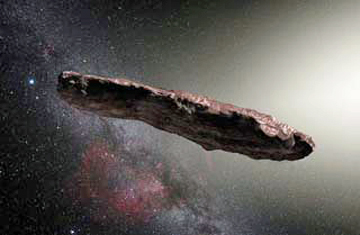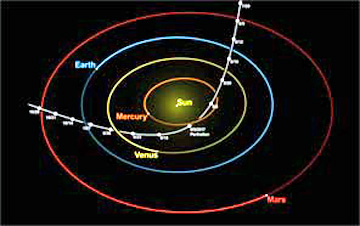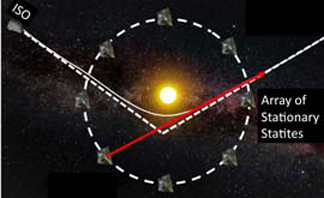|
Newsletter:
Perhaps you missed it, but we have already had a visitor from a star system far, far away — an Interstellar Object (“ISO”) named ‘Oumuamua that might look like this.

Not to worry. ‘Oumuamua means us no harm. At its closest approach to Earth, it was 60 times farther than our Moon, and is now on its way back to the great void of interstellar space.
We know ‘Oumuamua is an alien visitor because its speed exceeds the Sun’s escape velocity and its trajectory is hyperbolic. All moving bodies have kinetic energy (mv2/2)>0, and all bodies in the Sun’s gravitational field have potential energy (–GMm/r2)<0. Bodies whose energy sum, kinetic plus potential, is negative are bound to the Sun in elliptical orbits. Bodies with positive energy sum escape the Sun’s gravity, moving along hyperbolic trajectories, like that of ‘Oumuamua shown below. Here, the ISO enters at the top and exits left. The orbits of Mercury, Venus, Earth and Mars are shown in orange, yellow, blue, and red, respectively.

In interstellar space, ‘Oumuamua’s velocity was 59,000 mph. As it entered our Solar System, the Sun’s gravity accelerated it. As it passed the Sun, its speed reached 196,000 mph. By comparison, Earth orbits the Sun at 67,000 mph.
‘Oumuamua is the first detected alien body to enter our Solar System, although there were undoubtedly countless others that we never noticed. Robert Weryk discovered it with the PAN-STARRS telescope atop Haleakala on Maui. Its Hawaiian name roughly translates to “first distant messenger”.
Partly because it was the first of its kind, and arrived unexpectedly, we know very little about ‘Oumuamua. It seems long and narrow, with an estimated length of 300 to 3000 feet. Some speculate it might be a fragment of a planet torn asunder by tidal forces or cataclysmic collision.
Crimean amateur astronomer and telescope maker Gennadly Borisov found the second detected ISO, named 2I/Borisov.
No one knows when the next ISO will come, but the harder we look, the more we are likely to find.
Now that we know they exist, we naturally want to learn as much about ISOs as possible. But that requires new ideas, as ISOs can come from any direction, at any time, and can shoot by in only a few months. Scientists at MIT and JPL/Caltech have a scheme: an array of stationary satellites (“statites”) held in place by solar sails.
A solar sail is “pushed” by sunlight, by the momentum of solar photons. If sunlight’s outward push equals the Sun’s gravitational inward pull, the satellite can remain stationary indefinitely, awaiting a call to action. Remaining stationary without burning fuel requires low-mass satellites with large sails — the authors say at least 625 square meters of sail per kg (3200 square feet per lb).
The authors propose an array of statites. When our telescopes detect an ISO and we calculate its future trajectory, a command center on Earth will direct the most-favorably positioned statite to fly-by the ISO, or even better, to land on it.
As sketched below, a selected statite turns its sail and is accelerated by the Sun’s gravity. It can then use its sail for maneuvering. If a statite array had been in place when ‘Oumuamua arrived, one of them (red arrow) could have caught up to it (white curve) within 4 months.

Are the composition and evolution of other star systems different from ours?
Hopefully, these alien visitors have the answers.

Best Regards,
Robert
March 2021
Note: Previous newsletters can be found on my website.
|